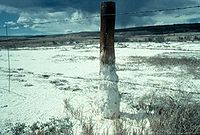
Photo from wikipedia
The hydrogeological and hydrogeochemical data of 75 groundwater samples and Landsat 8 OLI satellite data were used to identify the source and mechanism of groundwater and soil salinization in Femenin-Ghahavand… Click to show full abstract
The hydrogeological and hydrogeochemical data of 75 groundwater samples and Landsat 8 OLI satellite data were used to identify the source and mechanism of groundwater and soil salinization in Femenin-Ghahavand aquifer (FGA) in Hamadan area, Iran. Generally, the EC values range from 350 to 7556 μS/cm with a mean value of 1785 μS/cm. The salinity value increases in the groundwater along the flow direction from southeast to northwest. The water samples are categorized into two water types of HCO3–Ca and Ca2+–Mg2+–Cl−. The water samples are super-saturated with calcite and dolomite due to dissolution of carbonate rocks through the flow path from recharge to discharge zones and under-saturated with respect to gypsum and halite. The most probable source of salinity is dissolution of interlayer of halite and gypsum in Miocene Marl and Qom formation in the bedrock of FGA. Also, the ion exchange is another major process that affects the deep groundwater quality in FGA. The water samples of FGA were divided into two groups based on the HFE diagram. About 71% of the samples are plotted below the mixing line, indicating intrusion process with reverse ion exchange and the rest (29%) is under freshening process with direct ion exchange. Consequently, the source of salinity in FGA groundwater is dissolution of halite and gypsum in deep saline groundwater which is likely upconing and mixing with fresh groundwater during overexploitation. The result of soil investigation using NDS index based on Landsat 8 OLI satellite data shows severe increase in salinization from 2013 to 2019. The areas with saline groundwater have saline soil too, indicating same source of groundwater and soil salinization. However, the main cause of soil salinization would be land use change and irrigation by saline groundwater and high evaporation in the region.
Journal Title: Environmental Science and Pollution Research
Year Published: 2020
Link to full text (if available)
Share on Social Media: Sign Up to like & get
recommendations!